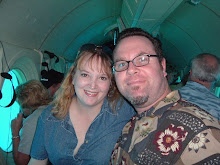I've been playing with PMC!!!!!!
Okay, okay, I know what you're thinking right now. You are probably saying "Huh? What the heck is PMC?"
Well, here's a brief description, from the Learning Center
http://www.thefamily-jewels.com/learningcenter.html on our website:
"PMC (Precious Metal Clay), is a clay-like medium used to make jewelry, beads and small sculpture. It consists of very small particles of precious metals (such as silver, gold or platinum) mixed with an organic binder and water. You shape the clay just like any soft clay, using your hands or moulds, leave it to dry, and then fire it. Firing can be done in a kiln, with a handheld gas torch, or in the case of Art Clay, also on a gas stove. The binder burns away, leaving just metal. The resulting object is smaller because the binder has been removed and the piece has shrunk during the process of sintering. Shrinkage from 8 to 30% occurs (depending on the brand used), but this has been exploited by artisans as it allows very fine detail to be achieved.
The silver version of the clay is the most-used of all metal clays, resulting in .999 pure silver. "
Sooooo, clear as mud?? Here are a couple of pendants I made previously using PMC. As you can see, it's pure silver, almost exactly like working with silver sheet, only a bit easier in many ways.

The reason I'm so excited about playing with it? Well this stuff is not cheap, actually it's pretty expensive. It runs about $29 for a little 20 gram chunk. I used a full 20 grams to make the pendant above, and another 20 grams to make the one below. It's not stuff you normally just play with, unless you know exactly what you are going to do with it.

Which is why I had an unopened 20 gram package of it sitting in the drawer for over 10 months. I was almost afraid to open it and use it. Well, a few days ago I finally came up with the perfect idea, so I made myself be brave and I opened up the package. I shaped and formed it the first night, and allowed it to dry for 24 hours. Then I filed it and smoothed the edges and used my torch to burn off the clay bonding. And finally today, I polished it up and oxidized it to bring out the design.
The result? Well, I'm sooooooo happy I made myself do it!!! I will get pictures of the finished product and share it!!



 Okay folks, here on our little journey, I am going to be taking you along sort of a side path, one that will help you understand one of my major jewelry loves - chainmaille. We will take the path in little bits and pieces, so as not to give you too much information at once. In fact, I'm sure I'll learn a ton along the way too!!
Okay folks, here on our little journey, I am going to be taking you along sort of a side path, one that will help you understand one of my major jewelry loves - chainmaille. We will take the path in little bits and pieces, so as not to give you too much information at once. In fact, I'm sure I'll learn a ton along the way too!!







